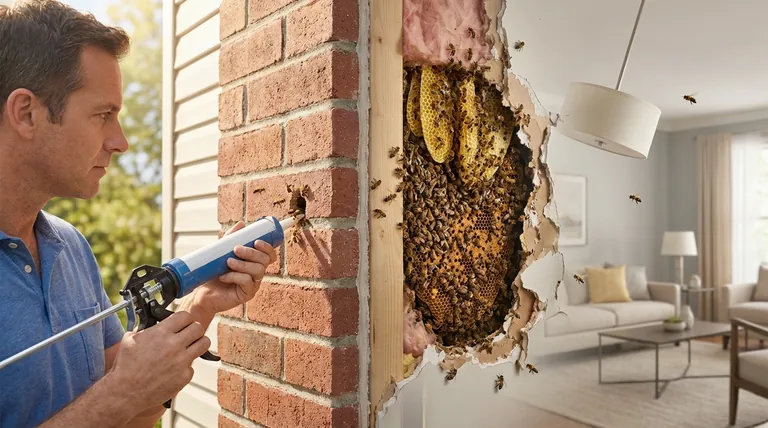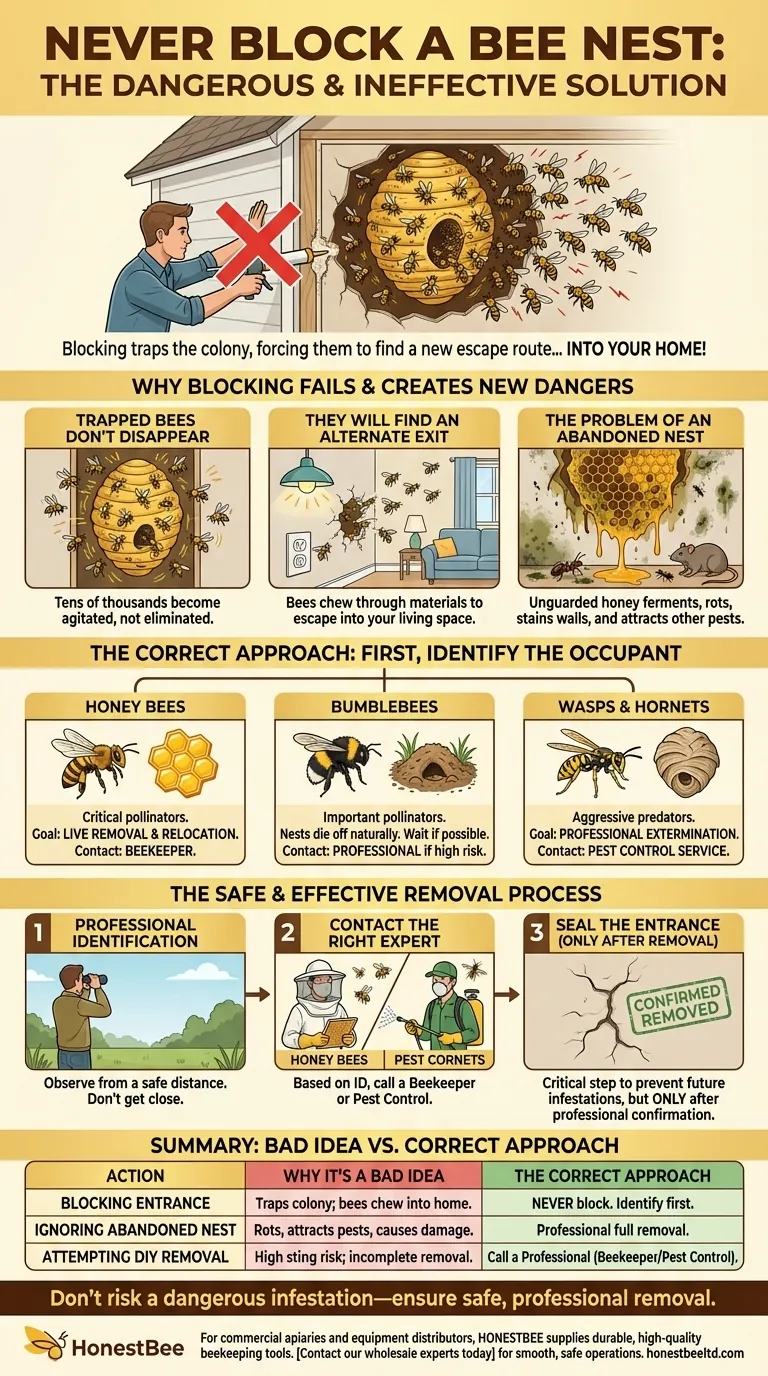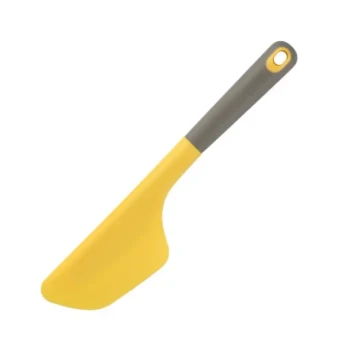While it may seem like a simple and direct solution, you should never block the entrance to an active bee nest. Doing so is not only ineffective at eliminating the colony but creates a significant risk of the bees finding their way inside your home, leading to a much more dangerous and difficult situation to resolve.
Blocking a bee nest entrance traps the colony inside, forcing thousands of agitated insects to chew through alternate routes—often drywall, floorboards, or ventilation—to escape directly into your living space. The correct approach is always to identify the insect and engage a professional for safe removal.

Why Blocking a Bee Nest Fails and Creates New Dangers
It’s a logical assumption: if the bees can't get in or out, the problem is solved. The reality is far more hazardous because this approach fails to account for the colony's powerful survival instincts.
Trapped Bees Don't Disappear
A mature honey bee colony can contain tens of thousands of individuals. Blocking their primary entrance does not cause them to die off quietly.
Instead, the entire colony becomes trapped and agitated. Foraging bees returning from the outside will cluster around the blocked entrance, while the thousands inside begin looking for a new way out.
They Will Find an Alternate Exit
Bees, wasps, and hornets are capable of chewing through various building materials, including wood, caulking, and especially drywall. When their main exit is sealed, they will actively seek the path of least resistance.
If the nest is within a wall void, this new exit is very likely to be on the interior of your home. You can go from having a manageable outdoor issue to thousands of distressed bees emerging from a light fixture, outlet, or wall seam.
The Problem of an Abandoned Nest
Even if you were to successfully kill the bees, a large, abandoned honey bee nest inside a structure is a secondary disaster. The unguarded honey will absorb moisture and begin to ferment and rot.
This process can saturate and stain drywall, attract other pests like ants, cockroaches, and rodents, and create a foul odor. The wax can also melt in high temperatures, causing further damage. Professional removal always includes extracting the honeycomb.
First, Identify the Occupant
The correct strategy depends entirely on what type of insect you are dealing with. "Bees" is a general term, and the right professional to call varies significantly.
Honey Bees
Honey bees are critical pollinators and are generally not aggressive unless their hive is threatened. They live in large colonies with wax honeycomb. If you have honey bees, the goal should be live removal and relocation.
Bumblebees
Bumblebees are also important pollinators, typically furry in appearance. They live in smaller colonies, often in cavities like bird boxes or underground. Their nests die off naturally in the fall, so if they are not in a high-traffic area, waiting is often the best option.
Wasps and Hornets (including Yellow Jackets)
These insects are often mistaken for bees but are generally more aggressive predators. Their nests are made from a paper-like material. Due to their aggressive nature, removal of these nests is a job for a professional pest control service.
The Safe and Effective Removal Process
The correct protocol involves three distinct steps that prioritize safety and a permanent resolution.
Step 1: Professional Identification
From a safe distance, try to observe the insects. Note their appearance and the location of the entrance. If you are unsure, a professional can identify them for you. Do not get close to the nest entrance.
Step 2: Contact the Right Expert
Based on the identification, you will call one of two types of professionals:
- For Honey Bees: Contact a local beekeeper or a specialized bee removal service. They have the equipment and expertise to remove the queen, colony, and honeycomb without killing the bees.
- For Wasps or Hornets: Contact a licensed pest control company. They will use appropriate methods to safely exterminate the colony.
Step 3: Seal the Entrance (Only After Removal)
Sealing the entry point is the final, critical step, but it must only be done after you have professional confirmation that the entire colony and nest material have been removed. This prevents a new colony from being attracted to the same desirable cavity in the future.
Making the Right Choice for Your Situation
Your immediate action should be based on the type of insect and the level of risk it presents.
- If you have honey bees in a wall or structure: Immediately call a professional beekeeper or a live bee removal service to safely relocate the colony and remove the honeycomb.
- If you are dealing with wasps, hornets, or yellow jackets: Contact a licensed pest control service for extermination, as these insects pose a higher sting risk.
- If you suspect bumblebees and they pose no direct threat: Consider waiting until late fall for the nest to die out naturally before sealing the cavity.
- If you want to prevent future infestations: Perform a thorough inspection of your home's exterior and seal any cracks or holes after confirming any current infestation is completely gone.
Ultimately, addressing a bee or wasp nest requires prioritizing safety over a quick fix.
Summary Table:
| Action | Why It's a Bad Idea | The Correct Approach |
|---|---|---|
| Blocking the Entrance | Traps and agitates the colony; bees will chew through walls to escape into your home. | NEVER block the entrance. First, identify the insect from a safe distance. |
| Ignoring an Abandoned Nest | Leftover honeycomb rots, attracts pests, and causes structural damage and foul odors. | A professional must fully remove the nest and honeycomb to prevent secondary damage. |
| Attempting DIY Removal | High risk of multiple stings and failing to fully eliminate the colony or nest. | Call a Professional: A beekeeper for honey bees or a pest control service for wasps/hornets. |
Don't risk a dangerous infestation—ensure safe, professional removal.
For commercial apiaries and beekeeping equipment distributors, proper hive management starts with the right tools and knowledge. HONESTBEE supplies the durable, high-quality beekeeping supplies and equipment you need to maintain healthy colonies and prevent issues like unwanted nesting.
Let us help you protect your investment. Contact our wholesale experts today to discuss your equipment needs and ensure your beekeeping operations run smoothly and safely.
Visual Guide

Related Products
- HONESTBEE Advanced Ergonomic Stainless Steel Hive Tool for Beekeeping
- Professional Dual-End Stainless Steel Hive Tool for Beekeeping
- Beehive Handle and Frame Rest Cutting Machine: Your Specialized Hive Machine
- Professional 3-Bar Frame Grip with Integrated Hive Tool
- Professional Long-Handled Silicone Honey Scraper for Beekeeping
People Also Ask
- Why is it important to compare the progress of different hives? A Beekeeper's Key Diagnostic Tool
- What are the features of a regular hive tool? The Essential Multi-Tool for Every Beekeeper
- What are some common uses of a hive tool? Essential Multi-Purpose Tool for Every Beekeeper
- How is a hive tool used for scraping and cleaning? Master Hive Maintenance for a Healthy Colony
- What tools are used for cleaning frames? A Beekeeper's Simple 4-Tool Guide



















